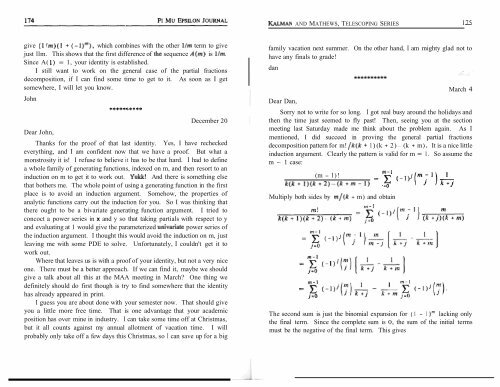Vol. 10 No 3 - Pi Mu Epsilon
Vol. 10 No 3 - Pi Mu Epsilon
Vol. 10 No 3 - Pi Mu Epsilon
- No tags were found...
You also want an ePaper? Increase the reach of your titles
YUMPU automatically turns print PDFs into web optimized ePapers that Google loves.
KALMAN AND MATHEWS, TELESCOPING SERIES 175 -give (1 Im) (1 + (- I)'"), which combines with the other llm term to givejust llm. This shows that the first difference of the sequence A(m) is llm.Since A( 1 ) = 1, your identity is established.I still want to work on the general case of the partial fractionsdecomposition, if I can find some time to get to it. As soon as I getsomewhere, I will let you know.JohnDear John,December 20Thanks for the proof of that last identity. Yes, I have recheckedeverything, and I am confident now that we have a proof. But what amonstrosity it is! I refuse to believe it has to be that hard. I had to definea whole family of generating functions, indexed on m, and then resort to aninduction on m to get it to work out. Yukk! And there is something elsethat bothers me. The whole point of using a generating function in the firstplace is to avoid an induction argument. Somehow, the properties ofanalytic functions carry out the induction for you. So I was thinking thatthere ought to be a bivariate generating function argument. I tried toconcoct a power series in x and y so that taking partials with respect to yand evaluating at 1 would give the parameterized univariate power series ofthe induction argument. I thought this would avoid the induction on m, justleaving me with some PDE to solve. Unfortunately, I couldn't get it towork out.Where that leaves us is with a proof of your identity, but not a very niceone. There must be a better approach. If we can find it, maybe we shouldgive a talk about all this at the MAA meeting in March? One thing wedefinitely should do first though is try to find somewhere that the identityhas already appeared in print.I guess you are about done with your semester now. That should giveyou a little more free time. That is one advantage that your academicposition has over mine in industry. I can take some time off at Christmas,but it all counts against my annual allotment of vacation time. I willprobably only take off a few days this Christmas, so I can save up for a bigfamily vacation next summer. On the other hand, I am mighty glad not tohave any finals to grade!dan - -3-. ..Dear Dan,March 4Sorry not to write for so long. I got real busy around the holidays andthen the time just seemed to fly past! Then, seeing you at the sectionmeeting last Saturday made me think about the problem again. As Imentioned, I did succeed in proving the general partial fractionsdecomposition pattern for m! /k(k + 1 ) (k + 2) - (k + m) . It is a nice littleinduction argument. Clearly the pattern is valid for m = 1. So assume them - 1 case:(m - l)!k(k+l)(k+2)-(k+m-1)m-I. s o<strong>Mu</strong>ltiply both sides by m/(k + m) and obtainThe second sum is just the binomial expansion for ( 1 - 1 )"I lacking onlythe final term. Since the complete sum is 0, the sum of the initial termsmust be the negative of the final term. This gives
















